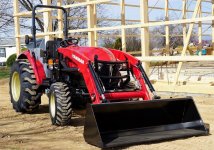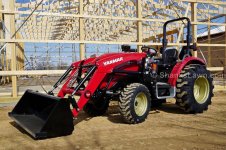SCUTS (sub compact utilty tractors)
CUTS (Compact utilty tractors)
then you get into the large set of tractors that start giving CAT 2 (category 2) 3pt hitch, and/or offering 5,400 RPM to 10,000RPM PTO on rear end of tractor
everything else beyond this, you are getting into huge tractors.
SCUTS = riding lawn mower on steroids.
CUTS = you get more clearance underneath tractor, you get away from riding lawn mower frame work, and you tend to get a heavier tractor, and you tend to get split rear brakes, possibly differential lock, and the engine compartment gets less crowded in sense stuff starts getting big enough, that it is easier to clean out the radiator, possibly have a transmission radiator, and a hydraulic oil cooler (radiator).
get yourself into CUTS, and outside of the SCUTS range. and stay below the CAT 2 3pt hitch 10,000 RPM tractors
================
some things that may or may not show up in SCUTS but begin showing up in CUTS
--is shuttle shift (lever by stearing wheel, flip it one way to go forward, flip another and you begin reversing),
--you might also start seeing same speed forward and same speed going in reverse,
--you may start seeing FEL more specialized joysticks / valving to make it quicker to raise /lower the FEL.
--you will more likely see brake pedals on the left foot, and gas / HST pedal on the right foot, so you can actually use both feet at same time to control brakes and gas / hst peddle.
=============
to state it to state it, stay away from "manual gear transmissions" go with some sort of HST / hydraulic transmission or like transmission. they use up a little more HP. but make life easier overall. from dailing right to wanted MPH you want to be at, to inching forward/backwards, to making going from forward/backwards much quicker. tractor is not driving forward all the time like car/truck. but a lot of backing up, going forwad, backing up going forward, along with turning around and getting yourself unstuck in muddy situations and keeping traction.
=============
with above said, 12 feet wide 350 feet long. a SCUT more than plenty, though having something nearing CUT ranges, might be better off.
when you bring in the road shared between homes. then ya tend to jump up to a larger tractor. more than you actually need for private usage.
=============
pot holes, wash boarding (little bumps), ditches, water on the shared road, driving to fast, water not running off of the road, water standing in ditches next to road. not having a good road base, not sloping the road correctly to edges, driving to fast (yet again), and driving to fast (give it one more time) on a dirt road. water on road and not flowing off of it and away from it in ditches (repeat this said multi times) can really do harm to a road.
other words... water = NO NO, driving to fast = a NO NO. when dealing with dirt drives / rock drives.
=============
if road has curves, ditches, culverts you need to get around, might suggest a TNT (top and tilt) for 3pt hitch, so you can adjust on the fly 3pt hitch. (replaces turn buckle on top link and replaces turn buckle on one of the lower lift arms with a hydraulic cylinder as well). to state it another way, instead of seating and forgetting about it a turn buckle. a TNT lets you adjust rear blade, box blade, land plain / scrapper grader blade while moving along.
you will most likely want "check chains" and sway bar/chains for the 3pt hitch as well.
rear blade, box blade with rippers, landplain / scrapper grader tend to be choices for dealing with rock / dirt roads/driveways. in order to maintain them. and tend to be a mix and match not just one, but 2 of them so you can get most things covered.
with you needing to deal with snow a FEL (front end loader) with general duty bucket most likely wanted, to deal with deeper snow drifts, and just plain moving dirt around between areas. without dragging dirt / snow around with a rear blade or box blade. rear blade is also good for snow removal. some folks go up to a snow blower. and some folks go up to a plow mounted to a regular pickup truck for dealing with snow.
===========
a cab may be worth it to you. just to get out of the bloody wind in winter. from an actual manufactured cab, to a soft cab, to diy cab. just getting the wind off you in winter makes a huge difference, even if you do not have heat, and/or a/c in the summer. if you are actually going to deal with shared road, a cab, can keep you from eating and breathing a few pounds of dust in summer.
===========
to toss it out there, you mentioned a larger truck. they do sell some "trailers" with an angled blade below it, along with a water tank on the trailer. and you just pull it like you would with a regular trailer, but with a remote control that goes up into front of truck. the blade can help deal with the road, and using the water tank to spray the road down to help keep the dust storm from happening.


